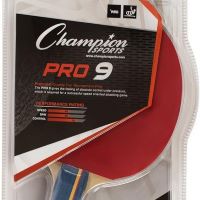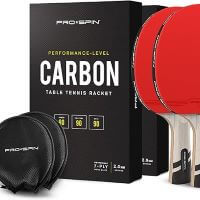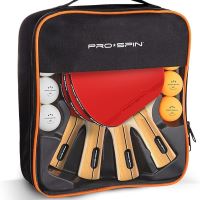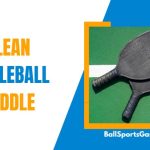Looking to explore the world of pickleball as a table tennis player? It’s crucial to grasp the game’s subtleties and find the right gear. Paddle choice is especially important in adapting to pickleball. In this guide, we’ll delve into the nuances of pickleball and table tennis paddles, offering valuable insights for table tennis players seeking the ideal pickleball paddle.
Whether you’re a seasoned table tennis player or just starting out, this guide will provide the knowledge you need to smoothly transition and thrive in the thrilling realm of pickleball. So, let’s jump right in and uncover the perfect pickleball paddle for table tennis players.
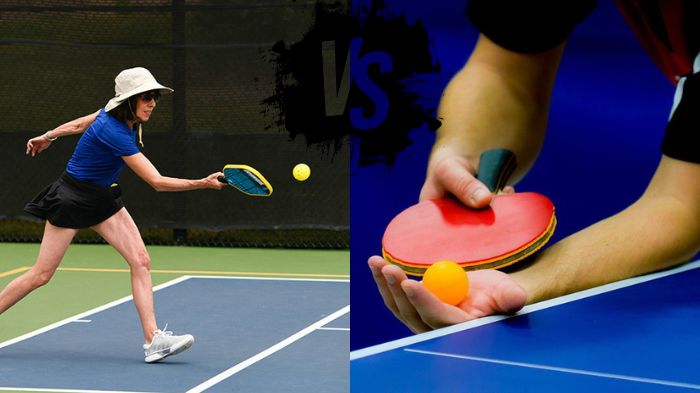
You Might Also Like:
Difference Between Pickleball and Table Tennis Paddles
When comparing pickleball and table tennis paddles, there are several key differences that players should be aware of. Understanding these distinctions between Elongated vs. Standard-Sized Pickleball Paddles can help table tennis players make an informed decision when transitioning to pickleball. Here are the main differences to consider.
Paddle Size and Shape
Pickleball paddles are generally larger and wider than table tennis paddles. The larger surface area of pickleball paddles provides a bigger sweet spot, making it easier to hit the ball. Table tennis paddles, on the other hand, are typically rectangular in shape, allowing for precise control and maneuverability.
Paddle Materials
Table tennis paddles are usually made of wood, offering a lightweight and responsive feel. Wood paddles provide excellent touch and control, allowing players to execute precise shots.
In contrast, pickleball paddles come in a variety of materials, including wood, composite, and graphite. Composite and graphite paddles are known for their durability and power, making them popular choices among pickleball players who value consistency and hitting power.
Grip Style
Table tennis paddles commonly have a flared grip that allows players to maintain a secure hold during fast-paced rallies. The flared grip shape provides stability and prevents the paddle from slipping out of the player’s hand. Pickleball paddles offer different grip styles, such as cushioned, perforated, or contoured grips.
These grip options provide players with choices for comfort and control, allowing them to find a grip that suits their playing style and preferences.
Weight and Balance
Table tennis paddles tend to be lighter in weight, allowing for quick maneuverability and agility. The light weight of the paddle enables table tennis players to react swiftly to the fast-paced nature of the game.
In contrast, pickleball paddles can vary in weight, with some players preferring a lighter paddle for increased speed and maneuverability, while others opt for a heavier paddle for added power and stability during shots.
To further illustrate the differences between pickleball and table tennis paddles, here is a table summarizing the key distinctions:
| Comparison | Table Tennis Paddles | Pickleball Paddles |
|---|---|---|
| Size | Smaller | Larger |
| Shape | Rectangular | Square with rounded corners |
| Materials | Wood | Wood, Composite, Graphite |
| Grip Style | Flared | Cushioned, Perforated, Contoured |
| Weight | Light | Varies (lighter or heavier options available) |
How to Choose the Right Pickleball Paddle for Table Tennis Players?
Making the transition from table tennis to pickleball requires choosing the right paddle that suits your playing style and preferences. Here are some key factors to consider when selecting a pickleball paddle as a table tennis player.
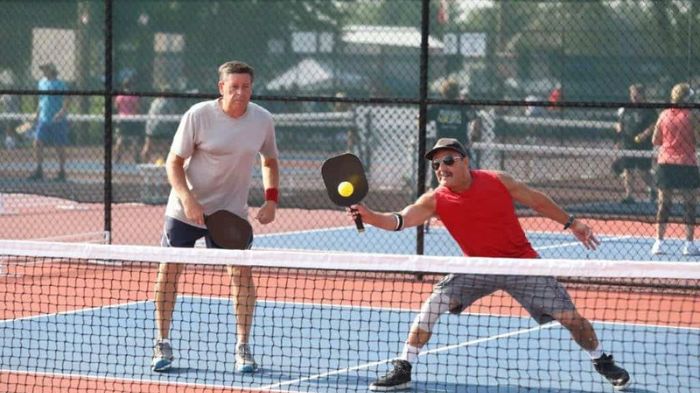
Evaluate Your Playing Style
- Consider your playing style in table tennis and how it translates to pickleball. Are you an aggressive player who prefers power shots, or do you rely on finesse and control?
- Look for a pickleball paddle that complements your playing style and allows you to execute your preferred shots effectively.
Consider Paddle Weight and Balance
- Pickleball paddles come in various weights and balances. If you are accustomed to the lightweight nature of table tennis paddles, you may prefer a lighter pickleball paddle for faster reaction times.
- Conversely, if you prefer a more solid feel and additional power, a slightly heavier pickleball paddle with a balanced weight distribution might be a better choice.
Examine Paddle Face Materials and Textures
- The face of a pickleball paddle can be made of materials like composite, graphite, or fiberglass. Each material offers different characteristics in terms of durability, power, and control.
- Additionally, consider the texture of the paddle face. A textured surface can provide better spin control and grip on the ball, similar to the textured rubber on a table tennis paddle.
Grip Size and Style
- Grip size is an important consideration for comfort and control. Pickleball paddles typically come in small, medium, or large grip sizes.
- Find a grip size that feels comfortable in your hand and allows for a secure hold during play. Consider whether you prefer a cushioned or non-cushioned grip based on your personal preference.
Seek Recommendations and Test Different Paddles
- Seek recommendations from experienced pickleball players or coaches who have made the transition from table tennis. They can offer insights and suggestions based on their own experiences.
- Consider testing out different pickleball paddles before making a final decision. Many sports stores or pickleball clubs have demo paddles available for trial. Testing different paddles will help you assess their feel, weight, balance, and overall performance.
How to Become Pickleball Player from Table Tennis Players?
If you’re a table tennis player looking to venture into the world of pickleball, here are some essential tips to help you make a smooth transition
A. Familiarize Yourself with Pickleball Rules and Court Dimensions:
- Take the time to understand the rules of pickleball, including scoring, serving, and court dimensions. While there are some similarities to table tennis, there are also key differences to be aware of.
- Study the court dimensions and positioning, as well as the specific rules regarding the kitchen or non-volley zone.
B. Adjust Your Stance and Footwork:
- Table tennis and pickleball have different stances and footwork patterns. In pickleball, a wider stance is often preferred to provide stability and a balanced base.
- Practice adjusting your footwork to accommodate the larger pickleball court and ensure proper positioning for shots.
C. Adapt Your Shot Selection and Strategy:
- While there may be some similarities between table tennis and pickleball shots, you’ll need to adapt your shot selection and strategy.
- In pickleball, there is more emphasis on placement and control rather than raw power. Work on developing consistent and accurate shots that keep the ball in play.
D. Practice the Dink Shot and the Third-Shot Drop:
- The dink shot, a soft and controlled shot that lands in the non-volley zone, is a crucial skill in pickleball. Practice this shot to maintain control during rallies and set up your next move.
- Additionally, focus on mastering the third-shot drop, a shot used after the serve and return to regain control of the game. This shot helps you get closer to the net while keeping the ball low and forcing your opponents into a defensive position.
E. Develop Power and Control in Your Pickleball Strokes:
- While pickleball may not require the same level of power as table tennis, it’s still important to develop a balance of power and control in your strokes.
- Work on generating power through proper body mechanics and weight transfer, while maintaining accuracy and control in your shots.
Learn About: Is It Allowed to Take a Pickleball Paddle in a Plane? And How to become 4.5 pickleball player?
What Advantage Does a Table Tennis Player Get?
If you are a table tennis player venturing into the world of pickleball, you already possess a set of skills that can give you an edge on the pickleball court. Here are some advantages your table tennis skills bring to the game.
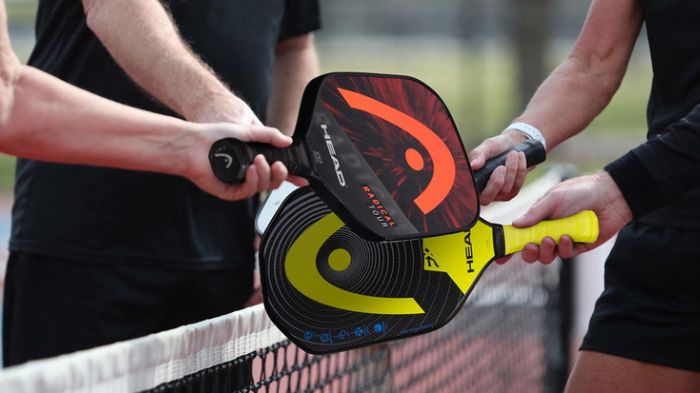
Quick Reflexes and Hand-Eye Coordination
Table tennis requires lightning-fast reflexes and exceptional hand-eye coordination, and these skills directly transfer to pickleball. Your ability to react quickly to the ball and make split-second decisions will give you an advantage in pickleball rallies, allowing you to anticipate and return shots effectively.
Precise Ball Placement and Control
Table tennis players excel in placing the ball precisely on the table, and this skill translates well to pickleball. Your ability to control the ball’s trajectory and placement can disrupt your opponents’ positioning, forcing them into difficult returns and opening up opportunities for winning shots.
Ability to Generate Spin and Add Variation to Shots
Table tennis players are well-versed in generating spin and adding variation to their shots, and this can be a valuable asset in pickleball. By incorporating spin into your pickleball shots, you can create different trajectories, making it challenging for opponents to predict the ball’s behavior and respond effectively.
Tactical Awareness and Shot Selection
Table tennis players possess tactical awareness and the ability to make strategic shot selections during a match. You can apply this skill in pickleball by analyzing your opponents’ strengths and weaknesses, adapting your shot selection, and making tactical decisions that give you an advantage on the court.
FAQs
While it is technically possible to use a table tennis paddle for pickleball, it is not recommended. Pickleball paddles are specifically designed with different materials, dimensions, and characteristics to optimize performance in the sport.
The main differences between pickleball and table tennis paddles include size and shape, materials used, grip styles, and weight and balance. Pickleball paddles are generally larger, made from various materials such as wood, composite, or graphite, offer different grip styles, and can have varying weights and balance.
To choose the right pickleball paddle, consider factors such as your playing style, paddle weight and balance, paddle face materials and textures, and grip size and style. Assessing these aspects will help you find a paddle that suits your preferences and playing needs.
As a table tennis player transitioning to pickleball, you may look for paddles with a familiar grip style, similar weight and balance to your table tennis paddle, and a paddle face material that offers good control and power. It’s also important to consider your own preferences and playing style.
Table tennis players transitioning to pickleball may prefer a grip style that is similar to their table tennis paddle, such as a flared grip. However, it ultimately depends on individual preference and comfort. It’s recommended to try different grip styles to find the one that suits you best.
Final Thoughts
In conclusion, transitioning from table tennis to pickleball requires understanding the differences in paddles, adapting your technique, and leveraging your table tennis skills. By selecting the right paddle, practicing the necessary adjustments, and embracing the similarities and advantages between the sports, you can excel in both table tennis and pickleball.
Remember to be patient, explore different paddles, and enjoy the journey of becoming a versatile player. Happy playing.

